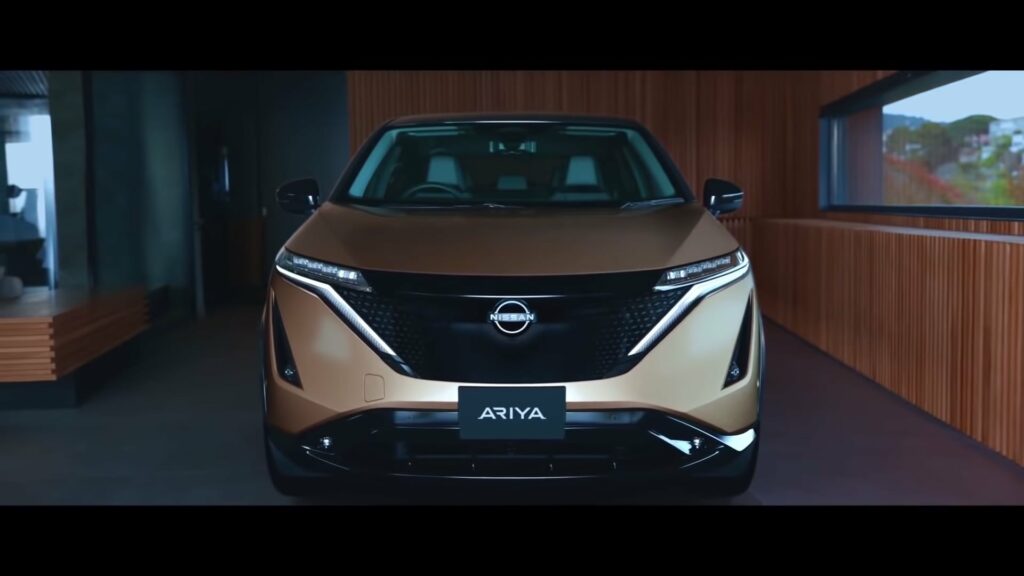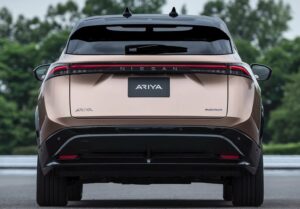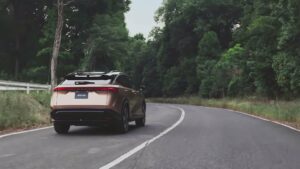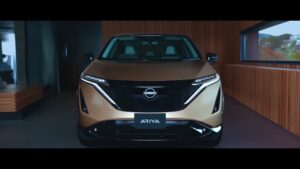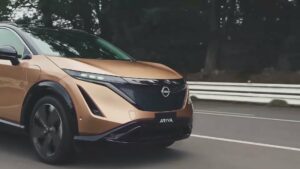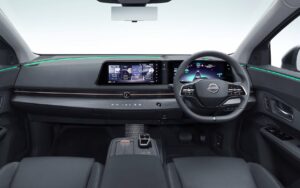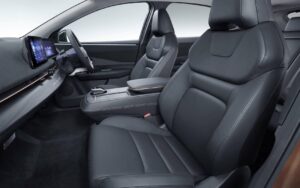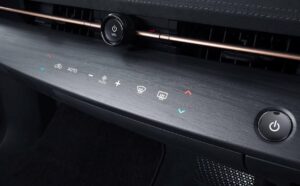Nissan Ariya 87kWh
The Nissan Ariya 87kWh is a variant of the Nissan Ariya electric SUV that features a more powerful battery pack, providing even more range. It is expected to be available for purchase in some markets in 2021.

The 87kWh Ariya features an 87kWh battery pack that provides up to 445 km of range on a single charge. The electric motor develops 178 kW, 300 Nm, providing a smooth and powerful driving experience.
The Ariya 87kWh features an elegant and modern exterior design, and a spacious and comfortable cabin with advanced features such as ProPILOT Assist 2.0, e-Pedal, adaptive cruise control, lane departure warning, and blind spot monitoring.

The 87kWh Ariya also comes with additional features such as an air purifier, a 12.3-inch digital instrument cluster, a 12.3-inch touchscreen infotainment system, and a 10.8-inch head-up display. In addition, the vehicle features Nissan’s new Ariya intelligent route planner, which uses real-time traffic data and weather forecasts to optimize the vehicle’s route and increase driving range.
Overall, the Nissan Ariya 87kWh is an upscale electric SUV with advanced features and plenty of range. It epitomizes Nissan’s commitment to the future of electric mobility and is sure to be a popular choice among those looking for a powerful and luxurious electric vehicle.
| Performance | ||
| Acceleration 0 – 100 km/h | 7.6 sec | |
| Top Speed | 160 km/h | |
| Electric Range | 445 km | |
| Total Power | 178 kW (242 PS) | |
| Total Torque | 300 Nm | |
| Drive | Front | |
| Battery and Charging | ||
| Battery Capacity | 90.0 kWh | |
| Battery Useable | 87.0 kWh | |
| Europe | ||
| Charge Port | Type 2 | |
| Charge Power | 22 kW AC | |
| Charge Time (0->445 km) | 4h45m | |
| Charge Speed | 96 km/h | |
| Fastcharge Port | CCS | |
| Fastcharge Power (max) | 130 kW DC | |
| Fastcharge Time (45->356 km) | 35 min | |
| Fastcharge Speed | 530 km/h | |
| Energy Consumption | ||
| EVDB Real Range | ||
| Range | 445 km | |
| Vehicle Consumption | 196 Wh/km | |
| CO2 Emissions | 0 g/km | |
| Vehicle Fuel Equivalent | 2.2 l/100km | |
| WLTP Ratings | ||
| Range | 500 km | |
| Rated Consumption | No Data | |
| Vehicle Consumption * | 174 Wh/km | |
| CO2 Emissions | 0 g/km | |
| Rated Fuel Equivalent | No Data | |
| Vehicle Fuel Equivalent | 2.0 l/100km | |
|
Rated = official figures as published by manufacturer. Rated consumption and fuel equivalency figures include charging losses.
|
||
|
Vehicle = calculated battery energy consumption used by the vehicle for propulsion and on-board systems.
|
||
| Real Energy Consumption Estimation between 133 – 276 Wh/km | ||
| City – Cold Weather * | 193 Wh/km | |
| Highway – Cold Weather * | 276 Wh/km | |
| Combined – Cold Weather * | 232 Wh/km | |
| City – Mild Weather * | 133 Wh/km | |
| Highway – Mild Weather * | 218 Wh/km | |
| Combined – Mild Weather * | 172 Wh/km | |
|
||
| Dimensions and Weight | ||
| Length | 4595 mm | |
| Width | 1850 mm | |
| Width with mirrors | No Data | |
| Height | 1660 mm | |
| Wheelbase | 2775 mm | |
| Weight Unladen (EU) * | 2000 kg | |
| Gross Vehicle Weight (GVWR) | No Data | |
| Max. Payload | No Data | |
| Cargo Volume | 468 L | |
| Cargo Volume Max | No Data | |
| Cargo Volume Frunk | No Data | |
| Roof Load | No Data | |
| Tow Hitch Possible | Yes | |
| Towing Weight Unbraked | No Data | |
| Towing Weight Braked | 1500 kg | |
| Vertical Load Max | No Data | |
| Miscellaneous | ||
| Seats | 5 people | |
| Isofix | No Data | |
| Turning Circle | No Data | |
| Platform | RNM CMF-EV | |
| Car Body | SUV | |
| Segment | JC – Medium | |
| Roof Rails | No Data | |
| EV Dedicated Platform | Yes |
Home and Destination Charging (0 -> 100%)
A public charging station is required to use the highest possible charging rate. The EVSE/charging station’s charging capacity affects how long it takes to fully charge the battery. The table below shows all possible options for fully charging the Nissan Ariya 87kWh .
In Europe, plugging an electric car into an outlet is often as easy as plugging it into a household outlet, but there are differences from country to country. The table below shows the different ways to charge the Nissan Ariya 87kWh , but in some countries some chargers may not be available.
Type 2 ( IEC 62196)

| Charging Point | Max. Power | Power | Time | Rate |
| Wall Plug (2.3 kW) | 230V / 1x10A | 2.3 kW | 44h30m | 10 km/h |
| 1-phase 16A (3.7 kW) | 230V / 1x16A | 3.7 kW | 27h45m | 16 km/h |
| 1-phase 32A (7.4 kW) | 230V / 1x32A | 7.4 kW | 14 hours | 32 km/h |
| 3-phase 16A (11 kW) | 400V / 3x16A | 11 kW | 9h30m | 47 km/h |
| 3-phase 32A (22 kW) | 400V / 3x32A | 22 kW | 4h45m | 94 km/h |
Fast Charging (10 -> 80%)
If you want to enjoy driving an electric car, one of the most important features to consider is the number of miles per hour the car can travel while charged. This is called the “range” of the car. All electric cars have a certain range, even if they are 100% charged. This is because they do not have an internal combustion engine to lean on if you need to drive a long distance.
Max. Power: The maximum power provided by the charging point
Avg. Power: The average power provided by the charging point during a session of 10% to 80%.
Time: the time it takes to charge from 10% to 80%
Speed: the average charging rate during the session of 10% to 80%
Combined Charging System (CCS Combo 2)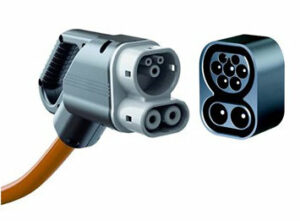
| Charging Point | Max. Power | Avg. Power | Time | Rate |
| CCS (50 kW DC) | 50 kW | 45 kW | 85 min | 220 km/h |
| CCS (100 kW DC) | 100 kW | 85 kW | 45 min | 410 km/h |
| CCS (150 kW DC) | 130 kW | 110 kW | 35 min | 530 km/h |
| Brand | Nissan |
| Model | Ariya 87kWh |
| Body Style | SUV |
| Car Engine | electric |
| Motor power | 178 |
| Maximum Torque, Nm | 300 |
| Battery Energy, kWh | 87.0 |
| Power reserve (NEDC/EPA/WLTP), km | - / - / 445 |
| Level Charging (230/400/DC), hours | - / 4.45 / 0.35 |
| Electrical Acceleration, 0-100 km/h (0-62.1 mph) in sec | 7.6 |
| Top Speed, km/h | 160 |












